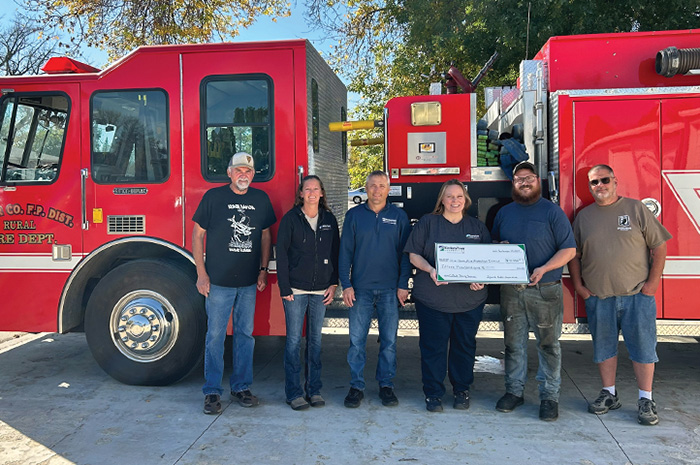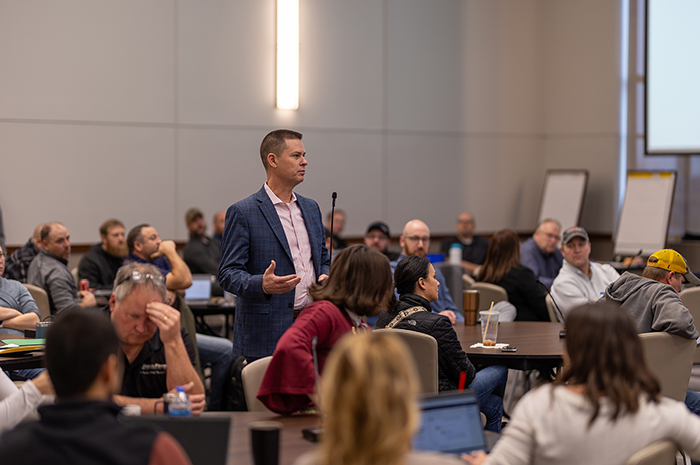Harnessing the grit of the grass
A Red River Valley Co-op Power business member is using native landscaping to improve the ecology of the prairie.
Blaine Keller joined the Marines after graduating high school in Grand Forks, N.D. A child of the Air Force, he knew the military was an opportunity to serve and see more of the world. When it was time to come back to the Midwest for college, he planted himself in an entirely new field – natural resources.
The outdoor kid was getting back to his roots, trading foreign lands for native prairies.
“My favorite native grass is the little bluestem, because of the fall color. It turns red,” he said in the warm calm of a greenhouse just south of Minnesota’s Buffalo State Park.
Keller is the site lead for the Glyndon outpost of MNL, an ecological restoration and native landscaping company. The mission of the organization is simple: positively impact the environment through innovative, natural means. But MNL’s methods are multifold, including producing native grasses and wildflowers for land restoration, creating pollinator habitats, performing multifaceted restoration construction work, responsibly managing unwanted vegetation growth (sometimes with goats and sheep), implementing prescribed fires, and mitigating damage to wetlands and streambanks.

In the rural service territory of Red River Valley Co-op Power (RRVCP), work like MNL’s is vital.
“We’re one of the most cultivated areas in the world, here in the breadbasket,” noted RRVCP CEO Rich Whitcomb. “MNL’s Glyndon site is actually farming, but it’s doing native farming of plants that have been here thousands of years. They’re harvesting it, and they’re using it to restore native prairies here in Minnesota and North Dakota.”
“Less than 4% of the native tallgrass prairie still exists in the U.S. today,” Keller said. He further described MNL’s goal of 10 20 30, through which they aim to positively impact 10 million acres by the year 2030. “That doesn’t mean we’re going to touch 10 million acres, but between us and our partners, those are the impacts that could be made upstream and downstream. If we touch one piece of land, it affects the land around it.”
The production of native grasses and wildflowers is a key specialty of the Glyndon site, one of four locations in Minnesota. Keller and his team oversee 500 acres, popping with a rainbow of colors from blanket flower, yarrow, verbena stricta, Echinacea and common ox-eye. The native plantings are harvested by machine or by hand, cleaned, determined to be wheat-free, sold to other vendors and customers, and used in MNL’s own restoration projects.

Native plants have deep roots that help stabilize soil in erodible, droughty or flood-prone areas. They withstand the harsh northern climate well, having evolved through four-season years dating back to pre-settlement times. Native grasses and flowers also act as nature’s clean-up crew.
“That deep-rooted vegetation captures a lot of carbon dioxide (CO2). It does a lot of transpiration and pulls a lot of CO2 out of the air. Deeper roots do more work,” Keller said. “It’s a big deal for carbon sequestration, as well as sedimentation and chemical runoff. The water goes in and gets filtered through the root system, it will clean that surface water, and recharge groundwater as a clean product.”

Partners in planting
MNL’s work doesn’t only impact private landowners on lakeshores and large companies with a lot of acreage to maintain. MNL partners with entities across the map, whether they’re seeking the ecological benefits or simply trying to follow permit codes.
“There are so many good people who support what we do for different reasons,” Keller said. He referenced a project collaboration in which one partner sought natural native landscaping while the other hoped for cleared, green recreation space. “We found a compatible use design, so it helps everybody involved. There is less land to mow for recreation, and we could add native features along the bike paths. That’s the great part about it.”

MNL also works with electricity providers like RRVCP and Minnkota Power Cooperative, who have a history of respect for the lands they use and serve. From eco-friendly vegetation management around power lines to the reclamation of coal mine regions, MNL is called in to help support the values shared between the organizations.
“Utilities provide something that’s greatly needed, and to mitigate that work, we can go back and bring the land back to something that may be better than when we started,” Keller said. “We’re doing our part to perpetuate environmental stewardship.”
One could say Blaine Keller likes to find balance in his world. People may know him as a courageous and tough-skinned Marine, but he recognizes that preserving the Minnesota he loves sometimes takes a light touch.
“I like to show people that just because you’re a conservative person doesn’t mean you can’t be concerned about the environment. There’s too much pressure put on that,” he said. “The main thing is just talking to people and making connections.”
MAIN IMAGE: MNL's Blaine Keller stands amidst one of several fields of native flowers grown and harvested by the MNL team near Glyndon.
...



